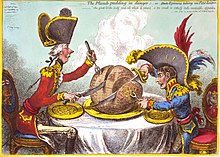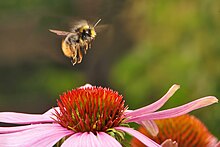History
Ancient to early modern history
- There is no evidence that Vikings wore horns on their helmets.[1]
- King Canute did not command the tide to reverse in a fit of delusional arrogance.[2]
- Christopher Columbus's efforts to obtain support for his voyages were not hampered by a European belief in a flat Earth. Sailors and navigators of the time knew that the Earth was like a sphere, but (correctly) disagreed with Columbus's estimate of the distance to India, which was approximately one-sixth of the actual distance. The intellectual class had known that the Earth was spherical since the works of the Greek philosophers Plato and Aristotle.[3] Eratosthenes made a very good estimate of the Earth's diameter around 240 BC.[4][5][6]
- There is a legend that Marco Polo imported pasta from China[7] which originated with the Macaroni Journal, published by an association of food industries.[8] Durum wheat, and thus pasta as it is known today, was introduced by Arabs from Libya, during their conquest of Sicily in the late 7th century.[9]
- Contrary to the popular image of the Pilgrim Fathers, the early settlers of the Plymouth Colony in present-day Plymouth, Massachusetts did not dress in black, wear buckles, or wear black steeple hats. According to historian James W. Baker, this image was formed in the 19th century when buckles were a kind of emblem of quaintness.[10][11][12][13]
- Marie Antoinette did not actually use the words "let them eat cake" when she heard that the French peasantry was starving because they did not have bread to eat. The phrase was first published in Rousseau's Confessions when Marie was only 10 years old. Marie Antoinette was unpopular, and many attributed the phrase "let them eat cake" to her, in keeping with her reputation as being hard-hearted and disconnected from her subjects.[14]
- George Washington did not have wooden teeth. According to a study of Washington's four known dentures by a forensic anthropologist, the dentures were made of gold, hippopotamus ivory, lead, and human and animal teeth (including horse and donkey teeth).[15]
- The United States Declaration of Independence was not signed on July 4, 1776. The final language of the document was approved by the Second Continental Congress on that date, it was printed and distributed on July 4 and 5,[16] but the actual signing occurred on August 2, 1776.[17]
- The United States Constitution was written on parchment, not hemp paper.[18]
Modern history


- Napoleon I (Napoleon Bonaparte) (pictured) was not as short as people thought.[19] After his death in 1821, his height was found to be 5 feet 2 inches in French feet. This is the same as 5 feet 6.5 inches in modern English feet, or 1.686 metres.[20][21]
- According to Time magazine, there is a common misconception among Americans that Abraham Lincoln freed all the millions of American slaves with the Emancipation Proclamation of January 1863,[22] but the Confederate constitution had prohibited other nations from freeing slaves in Rebel states. The Thirteenth Amendment, ratified on December 6, 1865, officially abolished slavery in all of the United States,[23] under President Andrew Johnson, 8 months after Lincoln had died.
- Italian dictator Benito Mussolini did not "make the trains run on time". Much of the repair work had been performed before Mussolini and the Fascists came to power in 1922. Accounts from the era also suggest that the Italian railways' legendary adherence to timetables was more myth than reality.[24]
- During the German Invasion of Poland in 1939, there is no evidence of Polish Cavalry mounting a brave but futile charge against German tanks using lances and sabres. Polish cavalry still carried the sabre, but were trained to fight as highly mobile, dismounted infantry and issued with light anti-tank weapons.[25][26]
- During World War II, King Christian X of Denmark did not thwart Nazi attempts to identify Jews by wearing a yellow star himself. Jews in Denmark were never forced to wear the Star of David. The Danes did help most Jews flee the country before the end of the war.[27]
- Albert Einstein did not fail mathematics in school. When shown a column claiming this fact, Einstein said "I never failed in mathematics... before I was fifteen I had mastered differential and integral calculus".[28][29]
- John F. Kennedy's words "Ich bin ein Berliner" are standard German for "I am a Berliner".[30][31] An urban legend has it that due to his use of the indefinite article ein, Berliner is translated as jelly doughnut, and that the population of Berlin was amused by the supposed mistake. The word Berliner is not commonly used in Berlin to refer to the Berliner Pfannkuchen; they are usually called ein Pfannkuchen.[32]
- Eva Perón never uttered the quote "I will return and I will be millions". The quote was first formulated by the indigenous leader Túpac Katari in 1781 shortly before being executed. The misattribution to Eva Perón originates from a poem by José María Castiñeira de Dios written in Eva Perón's first-person narrative nearly ten years after her death. There is a similar quote in the Spartacus movie.[33]






